Budget and Fiscal Plan 2005/06 – 2007/08 Update
September 14, 2005 • Ministry of Finance
Summary: BUDGET AND FISCAL PLAN –
2005/06 TO 2007/08
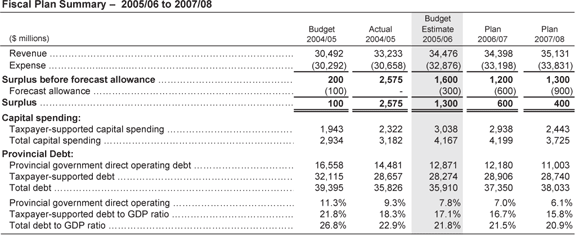
BC's fiscal position improves
Driven by stronger economic performance, the fiscal outlook of the BC government has improved since the February 15 budget. This has allowed:
- program enhancements for seniors ($242 million over three years); and
- a commitment to help build a new relationship with First Nations and Aboriginal communities ($100 million in 2005/06).
In addition to the small business threshold adjustment, the personal income tax reduction and medical service plan premium assistance enhancements for BC's low and modest income earners, announced in the February 15 budget, two new competitiveness measures are included in the September Update:
- a reduction in the general corporate income tax rate to 12 per cent from 13.5 per cent; and
- a tax refund for the commercialization of intellectual property in the form of life science related patents.
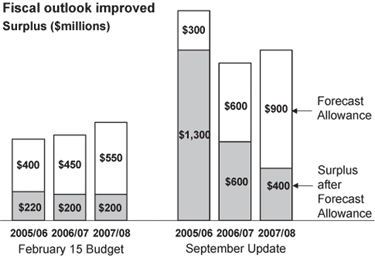
Since the February 15 budget, the province has also negotiated funding agreements with the federal government that enable expansion of key childhood development programs and programs in the forest sector:
- expansion of early learning and child care services ($329 million over three years); and
- support for the Mountain Pine Beetle Action Plan ($100 million over three years).
The September Update also reconfirms the spending and revenue initiatives tabled with the February 15 budget.
Budget plan remains prudent
With the September Update, government continues its legislated commitment to balanced budgets. The updated fiscal plan includes a forecast surplus of $1.3 billion for 2005/06, and surpluses of $600 million in 2006/07 and $400 million in 2007/08. The updated fiscal plan includes forecast allowances of $300 million in 2005/06, $600 million in 2006/07 and $900 million in 2007/08. These provisions protect the fiscal plan from revenue risks such as a sudden fall in energy prices, natural disasters and other unexpected spending requirements.
The forecast allowances must also cover potential wage and benefit increases arising from the next round of public sector bargaining, as no compensation increases have been included in this fiscal plan. Details of the next wage mandate will be released by the next budget in February 2006.
Surplus allocated to reduce borrowing requirements
To meet the transportation, health and education infrastructure needs of a growing economy, significant capital project investments are planned in the coming years for health care facilities, universities, colleges and highways. This leads to increases in debt over the course of the three-year plan, reflecting the borrowing requirements for planned capital projects. The three-year fiscal plan assumes that funds from the operating surplus are applied to reduce these borrowing requirements.
Debt to remain affordable
Government is committed to keeping debt affordable for future generations of British Columbians. Government will monitor the borrowing requirements for capital projects to ensure that debt does not grow faster than the overall economy. Consistent with this commitment, both total debt and taxpayer-supported debt are forecast to decline as a per cent of GDP in each of the next three years.
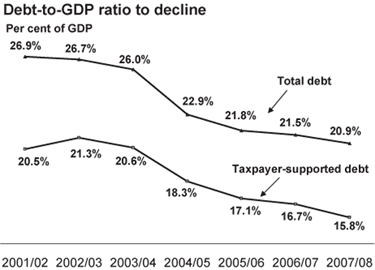
A strong economic foundation
The BC economy performed impressively in 2004, posting a real GDP growth rate of 3.9 per cent. Momentum continues in employment, consumer spending, home construction and non-residential investment, maintaining high levels of consumer and business confidence. This broadly based economic growth is expected to continue in 2005 and 2006. The Ministry of Finance forecasts economic growth of 3.4 per cent for 2005 and 3.2 per cent in 2006, up from the forecast in the February 15 budget.
The revenue outlook has similarly improved since February primarily due to higher taxation and energy revenues consistent with the updated economic forecast, as well as new federal government transfer payments. A strong economy and an improved financial position provide the underpinnings for continued enhancement of priority program areas, and for maintaining a competitive economic environment.
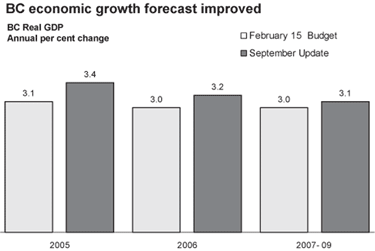
Seniors first to share in new benefits
The new commitments in this September Update incorporate initiatives to improve the lives of senior citizens. These include funds for:
- the renewal of the Seniors' Supplement for those with lower incomes;
- increased ceilings for eligibility under the Shelter Aid for Elderly Renters (SAFER) rent subsidy program; and
- strengthening and modernizing the full range of health care services for seniors.
Building a new First Nations relationship
The provincial government is committed to building a new relationship with First Nations and Aboriginal communities. In 2005/06, the provincial government plans to invest $100 million of one-time funding to help First Nations and Aboriginal communities build appropriate capacity to provide effective input and participate in the management of lands, resources and social programs. This will assist First Nations and Aboriginal communities in becoming active, supporting partners in relationships with government, business and other organizations.
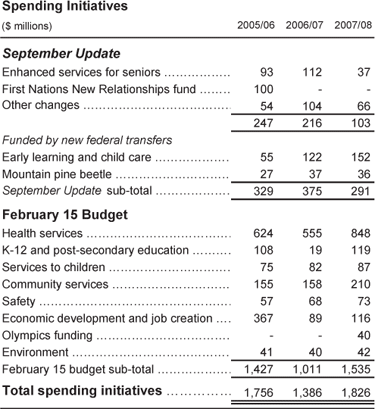
Early learning and child care
Additional revenues from a five-year agreement with the federal government will allow for expansion of the Child Care Subsidy program and creation of new child care spaces.
Mountain pine beetle
In addition to the $89 million provincial funding increase in the February 15 budget, a further $100 million received from the federal government will support the province's Mountain Pine Beetle Action Plan, and help respond to the increasing devastation of the pine forest in BC's interior.
Other changes
Other changes since the February 15 budget include a $50 million annual increase in the contingency vote to allow for unexpected costs or new initiatives. The contingency vote is now set at approximately 1 per cent of total government expense.
Maintaining a competitive environment
In addition to the tax relief measures in the February 15 budget, and already passed into law, the September Update includes measures to enhance BC as a competitive location for new business investment and to support job creation. The September Update includes a reduction in the general corporate income tax rate and a tax incentive to help keep intellectual property within the province.
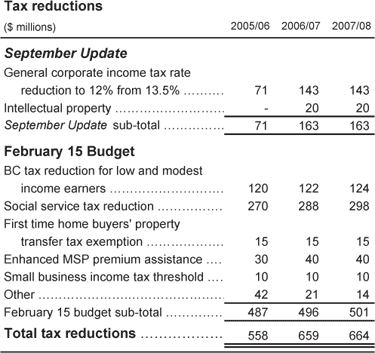
Expanded capital plan
The September Update includes a capital plan for ministries and Crown corporations, reflecting a three-year increase of $1.1 billion compared to the February 15 budget. This is mainly due to higher planned capital outlays by the post-secondary sector and health authorities based on updated plans from these sectors. Plan changes also include the increase for the Vancouver Convention Centre Expansion Project.

Infrastructure is costly to build, operate and maintain. But it is long-lived and delivers benefits across generations. Today's British Columbians are reaping the benefits of infrastructure investments made by their parents and grandparents. Infrastructure is clearly important to all British Columbians. Careful planning and budgeting is important so government can build new infrastructure, overhaul and update existing infrastructure and avoid bottlenecks, so that the province is left in good order for future generations.
Given the recent rise in construction material and labour prices, government will bring increased focus on capital spending proposals during the annual budget priority setting process, and will continue to monitor its infrastructure plan to ensure that all planned projects are managed within a declining debt-to-GDP track.
First Quarterly Report
In addition to the updated fiscal plan and its underlying assumptions, the September Update includes financial results for the April-to-June quarter of the 2005/06 fiscal year. These show a three-month surplus of $469 million mainly due to lower-than-expected spending in the first three months of the fiscal year.
2006/07 budget process
Due to the timing of the September Update, the debate on the 2005/06 Estimates will occur at the same time that the budget development process for 2006/07 gets underway. The Minister of Finance has released the 2006/07 Budget Consultation Paper with the September Update. This paper stands referred to a Select Standing Committee of the Legislative Assembly, which will seek public input on the February 2006 budget and hold public meetings in selected communities around British Columbia during late September and October.
|